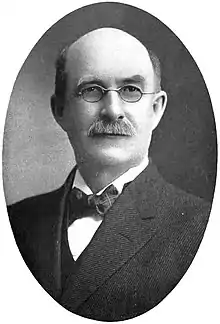Edward Angus Burt
Edward Angus Burt (April 9, 1859 – April 27, 1939) was an American mycologist and an authority on the resupinate (flat on the substrate) fungus family Thelephoraceae.[1][2] He received his M.A. in 1894 and PhD. in 1895, both from Harvard University under William G. Farlow and Roland Thaxter.[2] He became a Professor of Natural History at Middlebury College in 1895, then both a Professor of Botany at the Henry Shaw School of Botany at Washington University in St. Louis, and a mycologist for the Missouri Botanical Garden in 1913.[2] He also worked on a systematic description of basidiomycetes such as Merulius and fungi from Vermont, Siberia, and Java.[2]
Edward Angus Burt | |
|---|---|
 | |
| Born | April 9, 1859 |
| Died | April 27, 1939 (aged 80) |
The Septobasidium species S. burtii is named in his honor.[3][4]
References
- Farlow Herbarium, Harvard University, Farlow Herbarium
- EDWARD ANGUS BURT PAPERS (1895-1926), New York Botanical Gardens
- Septobasidium burtii, MycoBank
- Henk, D. A.; Vilgalys, R. (2007). "Molecular phylogeny suggests a single origin of insect symbiosis in the Pucciniomycetes with support for some relationships within the genus Septobasidium". American Journal of Botany. 94 (9): 1515–1526. doi:10.3732/ajb.94.9.1515. PMID 21636518.
- International Plant Names Index. Burt.
This article is issued from Wikipedia. The text is licensed under Creative Commons - Attribution - Sharealike. Additional terms may apply for the media files.